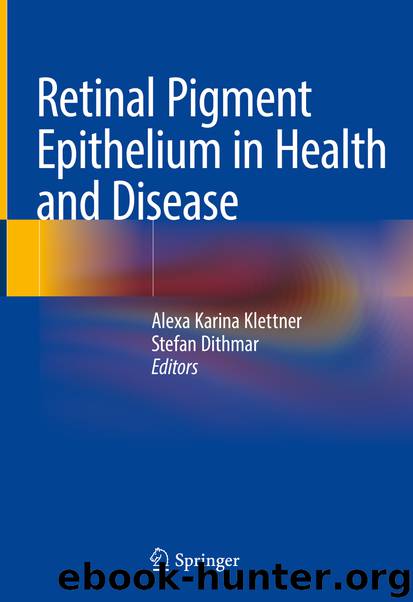Retinal Pigment Epithelium in Health and Disease by Alexa Karina Klettner & Stefan Dithmar

Author:Alexa Karina Klettner & Stefan Dithmar
Language: eng
Format: epub
ISBN: 9783030283841
Publisher: Springer International Publishing
Proteasomes and Lysosomal Autophagy in AMD
Maintenance of the cellular balance of proteins or protein homeostasis, also referred to as proteostasis, comprises the regulation of protein synthesis, folding, location, and degradation [27, 28]. Molecular chaperones, ubiquitin-proteasome degradation, autophagy-lysosomal pathway, and endoplasmic reticulum (ER) are central systems to regulate the proteostasis in cells (Fig. 9.1). Heat shock proteins (Hsps) are molecular chaperones that have a capacity to refold misfolded proteins. This is a unique system in cells to repair damaged proteins. Heat shock proteins protect RPE cells against oxidative stress, but it seems that the protective mechanism become weakened during the AMD process [31, 32].
Once Hsps’ repair capacity becomes exceeded, misfolded proteins have a tendency to gather into detrimental aggregates. Prior to protein aggregation, soluble proteins are tagged with small ubiquitin moieties that target damaged proteins to degradation in the large enzyme complexes called proteasomes. If proteasomes are not able to remove damaged proteins, and aggregation occurs, autophagy system tries to compensate the proteasomal response (Fig. 9.1; [27, 28]).
Autophagy, sometimes called self-eating, directs the degradation of unnecessary cellular molecules and organelles by delivering them to lysosomes where they become broken down by hydrolytic enzymes. Three basic types of autophagy are distinguished: macroautophagy, chaperone-mediated autophagy (CMA), and microautophagy [33]. Macroautophagy is mediated by the formation of autophagosome, a double-membrane vacuole that includes materials to be degraded. An autophagosome fuses with a lysosome, resulting in a structure called autolysosome, in which the final degradation of the cellular material occurs (Fig. 9.1). Microautophagy is conceptually the simplest mechanism of autophagy as it involves the direct uptake of cytoplasmic material thorough invaginated lysosomal membrane. Heat shock proteins Hsp90, Hsc70, or Hsp40 regulate the CMA process. The role of microautophagy or CMA in AMD is little known. Macroautophagy is considered as the major autophagic pathway and has been the most extensively studied in AMD research. It involves combined activity of autophagosomes and lysosomes where the hydrolysis by lysosomal enzymes is supported by several autophagy-related proteins (Atgs) [34]. In addition to basal regulation, autophagy is a host defence response to stress. The autophagic process is mainly regulated via the mechanistic target of rapamysin (mTOR) and adenosine monophosphatekinase (AMPK)-controlled signaling. Both of them are responsible for monitoring the nutritional status of the cell. Oxidative stress activates via AMPK host defence autophagy [35, 36].
There is mounting evidence showing that decreased autophagy in RPE cells is associated with the development of AMD [37–39]. One indication of that is the upregulation of the autophagy receptor SQSTM1/p62 , a protein shuttling between autophagy and proteasome-mediated proteolysis, and clearly present in the macula of AMD donor samples [39]. Circulating autoantibodies in AMD recognize human macular tissue antigens implicated in autophagy [40]. Moreover, autophagy proteins, autophagosomes, and autophagy flux are significantly reduced in tissue from human donor AMD eyes [38].
Download
This site does not store any files on its server. We only index and link to content provided by other sites. Please contact the content providers to delete copyright contents if any and email us, we'll remove relevant links or contents immediately.
| Anesthesiology | Colon & Rectal |
| General Surgery | Laparoscopic & Robotic |
| Neurosurgery | Ophthalmology |
| Oral & Maxillofacial | Orthopedics |
| Otolaryngology | Plastic |
| Thoracic & Vascular | Transplants |
| Trauma |
Periodization Training for Sports by Tudor Bompa(7893)
Why We Sleep: Unlocking the Power of Sleep and Dreams by Matthew Walker(6312)
Paper Towns by Green John(4759)
The Immortal Life of Henrietta Lacks by Rebecca Skloot(4229)
The Sports Rules Book by Human Kinetics(4050)
Dynamic Alignment Through Imagery by Eric Franklin(3894)
ACSM's Complete Guide to Fitness & Health by ACSM(3794)
Kaplan MCAT Organic Chemistry Review: Created for MCAT 2015 (Kaplan Test Prep) by Kaplan(3777)
Introduction to Kinesiology by Shirl J. Hoffman(3605)
Livewired by David Eagleman(3517)
The River of Consciousness by Oliver Sacks(3387)
The Death of the Heart by Elizabeth Bowen(3317)
Alchemy and Alchemists by C. J. S. Thompson(3273)
Descartes' Error by Antonio Damasio(3143)
Bad Pharma by Ben Goldacre(3071)
The Gene: An Intimate History by Siddhartha Mukherjee(2900)
The Emperor of All Maladies: A Biography of Cancer by Siddhartha Mukherjee(2885)
The Fate of Rome: Climate, Disease, and the End of an Empire (The Princeton History of the Ancient World) by Kyle Harper(2843)
Kaplan MCAT Behavioral Sciences Review: Created for MCAT 2015 (Kaplan Test Prep) by Kaplan(2786)
